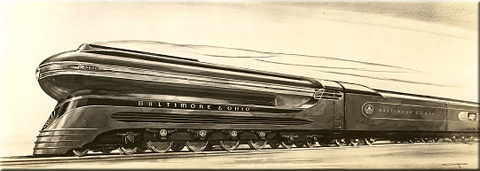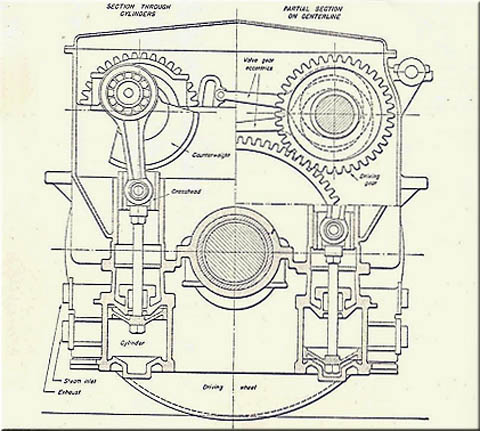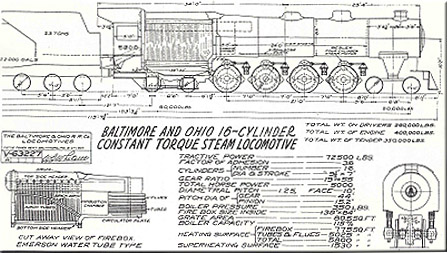- Home ›
- Stories ›
- Besler Type
The "Besler Type" (Class W-1): Diesel's Stillborn Competitor
Last revised: November 2, 2024
The Stillborn Competitor for the Diesel
By Bryan Porter
This is a story about a Steam locomotive the B&O designed and began to test that could have competed with the Diesel Locomotive, but it didn’t happen.
Why was it never built? Well, let’s take a look at the story and see what chain of events happened to cause this engine to be stillborn. Bill Barringer and Jim Mischke compiled the information for this story.
Mike Cather scanned all the data and provided CD’s to all participants. Bryan Porter drafted the article and final editing was done by Harry Meem to put the story together.
In a press release to the news media on September 22, 1937, B&O announced they had designed an engine that rivaled the tractive effort of the best engines ever built.
They had overcome the common trouble that steam engines have starting a train, namely inconsistent starting torque of reciprocating steam power and the inability to use all the power generated by the steam without the wheels slipping.
Steam can’t use all its power until reaching some degree of speed, and are slow getting to those speeds. The faster a steam engine runs, the more power it can use. (Diesels are able to use all of their power at low speed, stay at low speeds if need be, and get up to speed more quickly.)
Instead of having power delivered to the driving wheels every ¼ turn of the drivers as with conventional steam, B&O figured out how to incorporate the technology of Shay locomotive gearing with the high-speed ability of a road locomotive.
Looking at an artist’s rendering of the W-1 design, most people see it and say ‘Oh its a 4-8-4’ but that is not the case. What we actually see is a 4-2-2-2-2-4. In other words, each driving axle is independent of the others.
Note that the driving axles are not connected by any driving rods, so it cannot be described as a typical 8-coupled engine, thus a 2-2-2-2 set of drivers.
Now, each driving axle has its own “Besler” steam engine, containing 4 steam cylinders tied to a set of gears with a gear ratio of 55:19. That’s 55 gear teeth on the driving axle and 19 gear teeth on the crankshaft of the Besler.
Having 4 double acting cylinders on each drive axle gave the wheel 32-power strokes per revolution, and then with the gearing figured in, that made it actually 92+ power strokes per revolution.
That gave the driver a virtually continuous power stroke almost the same as an electric motor on a diesel. Compared to the normal 4 power strokes per conventional steam engine, the advantage is not getting wheel slip when starting the train and quicker acceleration.
Basically the power stroke is divided into 92 instead of 4 with each wheel revolution and that gives a much smoother power transition to the axle.
Also since there is no main rod or side rods there is no need to have counter weights so the drivers no longer pound the rail, which historically caused a lot of damage to the track.
As an example, a typical Mountain class locomotive on the B&O had a reciprocating weight on each driver equal to about 1747 pounds.
Given a certain thrust or pound on the rail as this weight strikes it, say at 5 miles per hour, this thrust increases as the square of the speed. For instance at 10 miles per hour, it would be four times as great.
So let’s talk about the engines on the drivers. Each of its four driving axles were driven by a Besler steam engine and each motor had four cylinders directly geared to its axle, a total of 16 cylinders driving the locomotive.
The cylinders were 10 ½ by 8 inches. Their design carried United States Patent Number 2,134,072 dated October 9, 1936 awarded to William J. Besler, who graduated with honors from Princeton in 1926.
Besler was active in the railroad industry in a number of efforts and set up his own company in the Bay Area of California. In conjunction with his brother, George Besler, the two men also ran a second company in Davenport, IA to construct steam-powered devices.
They believed that the power potential of steam was greatly overlooked and dedicated themselves to designing devices that could unlock and harness that power.
The brothers held other patents, devised power plants known as “flash boilers” and otherwise tried to improve on steam power at a time when other forces were taking the railroads in another direction.
The gears and other parts of the steam motors were designed to operate in a continuous bath of oil force-fed by a pump to the wearing parts, much like an automobile engine.
The cut-off and forward/reverse position of the valve gear were to be regulated from the locomotive cab by means of an electro-pneumatic control. Design weight of the W-1 was 400,000 pounds, with 260,000 of that on the drivers.
Starting tractive power calculated out to be 72,500 pounds, giving a factor of adhesion of 3.6. That is ample where there is a continuous torque output to the drivers.
The boiler was to be an Emerson water tube firebox type boiler with 775 sq. ft. of heating surface in the firebox, with a total heating surface of 5800 sq. ft.
Operating pressure was 350 PSI, much higher than most B&O steam power. The super heater was to have 1580 sq. ft. heating surface, and equipped with a feed water heater.
The Besler steam engines operated at a guaranteed 14 pounds per hour/ power hour so when the engine is developing 5000 HP the boiler is generating 70,000 pounds per hour of steam.
With all the appliances the boiler would actually be generating 80,500 pounds per hour of steam. The conversion of steam pounds per hour and water pumped from the tender is simple.
Water weight is 8.33 pounds per gallon, so 80,500 divided by 8.33 = 9,663.87. Now to bring that down to terms, divide by 60 minutes in an hour, and again 60 seconds in a minute and you get a water use of 2.68 gallons per second from the tender at full output of the boiler.
The tender would be one of the largest Vanderbilt tenders on the B&O with a capacity of 23 tons of coal and 22,000 gallons of water.
Doing the math from above, the engine could operate at full output for a little less than 2 ½ hours before running out of water. This 5000 HP rating was at a speed of 100 MPH. So draw your own conclusions there!
The drivers are suspended by outside frames and spring rigging that would allow it to be very flexible.
Since each driving axle was independent, it would be able to swing and follow any curvature on the railroad, unlike the large 8-or 10-coupled big steam where the driving wheels were coupled in a single rigid configuration, account of the driving rods Driver size was set at 60-inches.
They even planned for breakdowns. The outside bearings could be removed and a single driver set that might have a problem could be easily dropped into a pit for repairs or replacement.
On paper, the W-1 was born at 112 feet long, with the general appearance of a 4-8-4 with a water tube firebox. The assigned number series was 5800 and this being the first it was to carry the class number of 5800.
The plan was then to streamline the boiler for looks and wind resistance efficiency. No less than Otto Kuhler was engaged for the design, and the artist’s rendering of his concept is another classic Kuhler-inspired beauty.
This was to be a great engine, the pride of B&O engineering and industry leadership. By the way, Society member Mike Lytle owns the original artwork of Kuhler’s design, and it truly is a thing of beauty.
Daniel Willard was proud of this “Ideal Engine” and totally behind building it. His long administration, like many preceding him, was full of motive power inventions.
Like the first articulated engine, Old Maude. The Emerson. The Lord and Lady Baltimore, and quite a few others can be added to that proud list.
The B&O implemented a score of water tube boilers on Mikado’s and other engines. Many if not most of these experiments turned out to be red ink in the B&O books. But as long as Daniel Willard was in the driver seat, pioneering of new steam would continue on the B&O.
Willard had his own “skunk works” of a sort, led by the eccentric Colonel George Emerson who, along with his chief mechanical officer Bill Whitsett, innovated and tinkered with great enthusiasm.
Within walking distance of their offices, the considerable resources of the full set of B&O shops at Mt. Clare were at their disposal.
With huge shops and thousands of skilled shop craft workers on location, virtually anything could be fabricated on-site and with a good deal of secrecy. What a playground!
The latter 1930’s were ripe for new passenger and freight locomotive engine designs. NYC was talking about a Hudson bigger even then their massive J-1.
Upstart EMD was starting to come out with a working diesel-electric that seemed to also have promise. It was expected that the W-1 could run 15% more efficient than comparable engines out there at that time.
Superpower steam was a strong player. Massive articulated engines ruled mountain grades, with bigger yet to come when WW-II unleashed massive tonnage. Despite the Great Depression, these were still glory years for railroading.
What happened that the engine never came to be? Well the story goes like this.
The engine died in its cradle of blueprints because Daniel Willard had to choose between a tentative advance in locomotive power and design, or the financial security of his railroad and its people.
The B&O historically carried heavy debt, and the Depression took the B&O financially into a very hard place indeed. That B&O did not go into bankruptcy during this terrible decade is a tribute to Willard’s railroading leadership and President Franklin D. Roosevelt’s efforts to keep the country afloat.
But Uncle Dan had his hands full trying to keep the railroad out of court. By 1937 it looked as if all was well, but then came a second slump.
Gross revenues in the recession slumped to a low of $134.7 million from $169.4 earlier. After that the B&O system was concerned to stay afloat and that left no room for tinkering with the 5800.
Also at that time Daniel Willard found the EMD locomotive was just what GM had promised it to be.
So with the uncertain expenses and experiments still needing to be done, and the EMD diesel-electric already proving itself, the fate of B&O 5800 was sealed and it remained on the history shelf, another good idea that never saw the light of day.
By 1940 the B&O was back on its feet, but the diesel was now proven and President Willard ordered a stop to all further steam experimentation.
According to the Baltimore and Ohio magazine Sept. 1937. The boiler was built, altered, and placed on a frame of a P-9b, #5310. Also one motor set was bought and placed near the plant powerhouse and ran on test from a V-1 supplying steam.
Bill Barringer, who actually worked at the Mt. Clare shops, doubts the information that the boiler was used on the P-9b because as he states “I have copies of both the W-1 and P-9b (5310) diagrams, and the boilers and fireboxes do not have many common dimensions.”
The possibility of the boiler having been modified that much is there but no one will know for sure. Bill and I have E-mailed each other wondering what the B&O had planned for handling Wheel slip.
On a conventional engine all drivers would slip at the same time and the engineer would close down on the throttle. On the Diesel electric the wheels are driven by motors and one the first generation engines when one wheel set would slip the engine would automatically slow down and then pick back up.
On the W-1 how would they have indicated to the engineer that a wheel set was slipping?
Bill relates an incident where that Besler test motor was dropped while being moved, maiming the leg of Buz Eyerly, Foreman of Shop #4, leaving him limping forever after.
Mike Cather adds that his father worked with Buz, and his brother Ike Eyerly. He recalls his father often speaking fondly of them. It’s been 50 years now, but Mike remembers going to see the Baltimore Orioles play with his dad, the Eyerly’s, and a few other long-gone shop foremen.
After the game they went out for crab cakes and beers, with 8-year old Mike playing nickel slot machines while the bartender looked the other way.
So, what became of the B&O press release that trumpeted the wonders of the new W-1?
Well, Bob Van Sant, the venerable B&O Public Relations head, took a lot of ribbing from his peers in the railroad industry for putting out a release before the engine was a reality, but no lasting harm was done to his reputation.
Those who collect old copies of B&O Magazine will see his stories running in the employee publication for many years. Daniel Willard stepped down in June 1941 and passed away in July 1942.
Colonel Emerson retired in 1942 at age 70. Willard, Emerson, Whitsett, Besler, Eyerly, and the W-1, all belong to history now.
The W-1 would have certainly given the diesel a run for its money, at least for a while, possibly postponing the inevitable.
I wonder now with oil prices so high why we don’t pull the blue prints off the shelf and try again. This time we could add things like a steam separator, and a condenser to trap the steam from the cylinders and put it back into the boiler as condensate.
Then filter the remaining exhaust through a bag house to remove particulates from the stack gasses. Who knows, even add Limestone to the coal to change the sulfur dioxide to a tolerable level.
With bulk Ohio coal at about $41.00 a ton, that is comparably lower than the price of diesel fuel per BTU. Just a dream but you know there is no harm in dreaming.
Some day maybe our children and grandchildren will stand trackside, camera in hand, watching a steam engine fight the hill with a giant plume of steam rising several hundred feet in the air from the stack.
You hear the train at the railroad crossing just out of town, that lonesome sweet sound of a finely tuned whistle coming from the distance, as then you see the headlight approaching of long heavy coal train bringing in more fuel for the nations power plants and industries.
Just like many generations before us used to see every day. The hope of steam resurrected on the railroad stays strong in my heart.
There is nothing more graceful and awesome than the sight of a steam locomotive with such a mass of steel working hard pulling the nations tonnage across the land.
Recent Articles
-
New York Wine Tasting Train Rides: A Complete Guide
May 24, 25 02:18 PM
This article will delve into the history, offerings, and appeal of wine tasting trains in New York, guiding you through a unique experience that combines the romance of the rails with the sophisticati… -
Indiana Wine Tasting Train Rides: A Complete Guide
May 24, 25 01:50 PM
In this article, we'll delve into the experience of wine tasting trains in Indiana, exploring their routes, services, and the rising popularity of this unique adventure. -
Ohio Wine Tasting Train Rides: A Complete Guide
May 24, 25 11:07 AM
Among the intriguing ways to experience Ohio's splendor is aboard the wine tasting trains that journey through some of Ohio's most picturesque vineyards and wineries.





